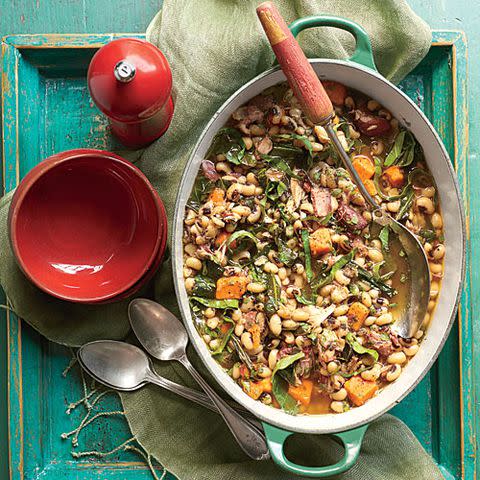Why We Eat Black-Eyed Peas And Collard Greens On New Year's Day
For anyone who has ever taken this tradition for granted, here's its origin.
Fact checked by Khara ScheppmannMedically reviewed by Jerlyn Jones, MS, MPA, RDN, LD, CLT
The South is a region of long-held superstitions and traditions. However, one of our longest-held traditions is that of eating black-eyed peas and collard greens in some form on New Year's Day. In fact, this tradition is so pervasive throughout the Southeast that black-eyed peas appear in recipes as varied as Cowboy Caviar in Texas to Hoppin' John in Alabama to peas with ham up in North Carolina.

What Is The Meaning Of Black-Eyed Peas And Collard Greens?
According to legendary Southern food researcher John Egerton's Southern Food: At Home, On the Road, In History, black-eyed peas are associated with a "mystical and mythical power to bring good luck" and have been a Southern staple for more than three centuries. As for collard greens, they're green like money and will ensure you a financially prosperous new year. And isn't that what we all want anyway?
There's evidence that Jewish people ate black-eyed peas as a part of the holiday Rosh Hashanah, the Jewish New Year, for hundreds of years. But the tradition of cooking black-eyed peas with rice is African in origin. It spread throughout the South, especially in the Carolinas, in the form of pilaus or rice dishes simmered for a long time with chicken or shrimp. When black-eyed peas were added to the pilau, it became Hoppin' John.
What To Serve With Your Black-Eyed Peas
If you serve peas with cornbread, it represents gold, and if they are stewed with tomatoes, it symbolizes wealth and health. Although we don't endorse this practice, some people will even put a penny or a dime inside their pot of peas. Whoever is "lucky" enough to receive the coin will have the most luck for the rest of the year.
Recipes For Black-Eyed Peas And Collard Greens
The classic New Year 's Day pairing isn't confined to the home either. You'll find black-eyed peas and collards on restaurant menus and daily specials throughout the South as the New Year approaches. However, if you want practice the tradition yourself, here are a few of our favorite recipes to try at home.
For more Southern Living news, make sure to sign up for our newsletter!
Read the original article on Southern Living.
